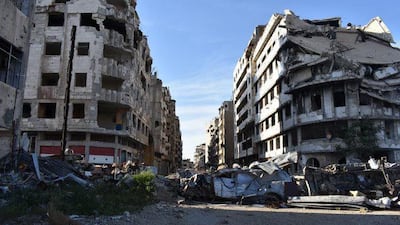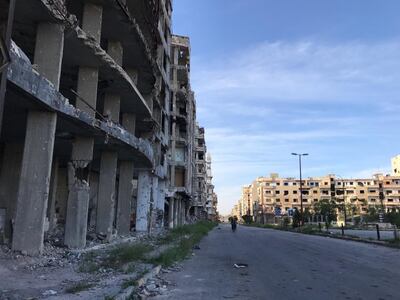More than 20,000 families have returned to Syria’s Homs in the past two years, according to the city’s governor, yet an eerie emptiness prevails in the area that has been under complete regime authority since 2014.
A community meeting in the Christian quarter of the old city of Homs, descends into farce, as residents carefully selected to share their tales of anguish at the hands of the opposition to a rare visiting foreign delegation.
Tales of tragedy turn to very public displays of loyalty to the regime - MPs and the province's governor look on approvingly.
Anti-government slogans in Homs, which was once dubbed the “capital of the revolution”, have been whitewashed from the walls and, instead, portraits of President Bashar Al Assad keep a sternly watch over the streets.
Even in the areas untouched by the bombings, shop fronts were shuttered with the dominating red, white and black Syrian flag painted on them.
Gareth Browne reports from Syria: There's only one winner from missile strikes in Damascus
Despite the Assad government’s insistence that life is returning to the city, Sunni areas — where anti-government sentiment was strongest and destruction most devastating — were barren.
Some have returned, but a closer examination of exactly who is returning to Homs reveals a concerted regime effort to make sure the city can never again be Syria’s spark.
Governor of Homs Talal Al Barazi said during the community meeting that 21,000 families have returned to the city since 2016, but this is far from any sort of reconciliation between the government and opposition.
The government has actively encouraged and incentivised an influx of Assad loyalists from the Alawite heartlands on the Mediterranean coast. Though they are not transplanted into the heart of the city, new housing projects on the southern periphery house the demographic change.
Much of the reconstruction that has taken plane in Homs has been limited to Christian areas, overseen by the Syrian patriarch — an institution that has become increasingly close to the regime since the war broke out in 2011.
Churches and shrines are busy workshops, storing piles of freshly built pews covered in saw dust.
Khalid ibn Al Walid Mosque in Homs has also been reconstructed, something the government has been keen to show off, but as one man who spoke to The National and wished to remain anonymous said: "There is no one here to pray in it."
_______________
Read more:
Syria’s chemical attacks: A timeline of the war's confirmed cases
Syria retracts reports of new missile attack in Homs
Turkey distances itself from Iran, Russia and US on Syria
_______________
While church leaders show off renovated chapels and reconstructed altars, there is little mention of reconstruction in the predominantly Sunni areas — where residents are nowhere to be scene and regime flags are slapped on front doors.
Church officials claim that at least seven churches, of varying denominations, have been rebuilt in the city at a cost of millions of dollars.
The fear is that the continued neglect of communities that at some stage supported opposition groups in favour of loyalist areas will only create further resentment between communities.
"My Alawite friends come into the city for work. They live close, but not too close," Mania Khashoun a communications trainer from Homs' Hamdiya district, tells The National.
Sanaa Abu Zeid, MP from Homs, said: “We are rebuilding Homs in the design of our president. Bashar Al Assad is personally driving the reconstruction.”
"Everything that has been achieved, and that will be achieved is through the efforts of the army and the will of our president,” said Mrs Abu Zeid through a crackling microphone at the meeting.
It is not only the reconstruction of the city’s buildings that has been inherently political, but also the writing of its history.
Read more: Exclusive: Notebook found in Raqqa prison reveals ISIS's thirst for blood
The memory of popular protest, or any kind of legitimate grievance, is being silenced from the official history of Homs.
"I remember the first days — I asked the kids protesting, I called from my balcony 'How much are they paying you?' They said 500 Syrian pounds (Dh3.5) each," Haysam Kozma, 61, tells The National during a carefully orchestrated tour of the Old City.
Meanwhile, what people think in the safety of their own homes when the Alawite Mukhabarat minder is not around is left to supposition.
"My family is from the same village as Assad," the minder boasts to The National. "Now I'm doing security in Homs."
Whether Homs will ever welcome back those communities who saw hope in the opposition is far from certain, as the words ‘opposition’, ‘terrorist’ and ‘Wahhabi’ are seemingly synonymous in Assad’s Syria.
“The normal ones [Sunnis] are OK, but I don’t think the Sunnis will come back, they’ve got no hope,” Mr Kozama says. “It was very good [before the war], but I don’t see how we will go back to that time, it’s going to be different.”



